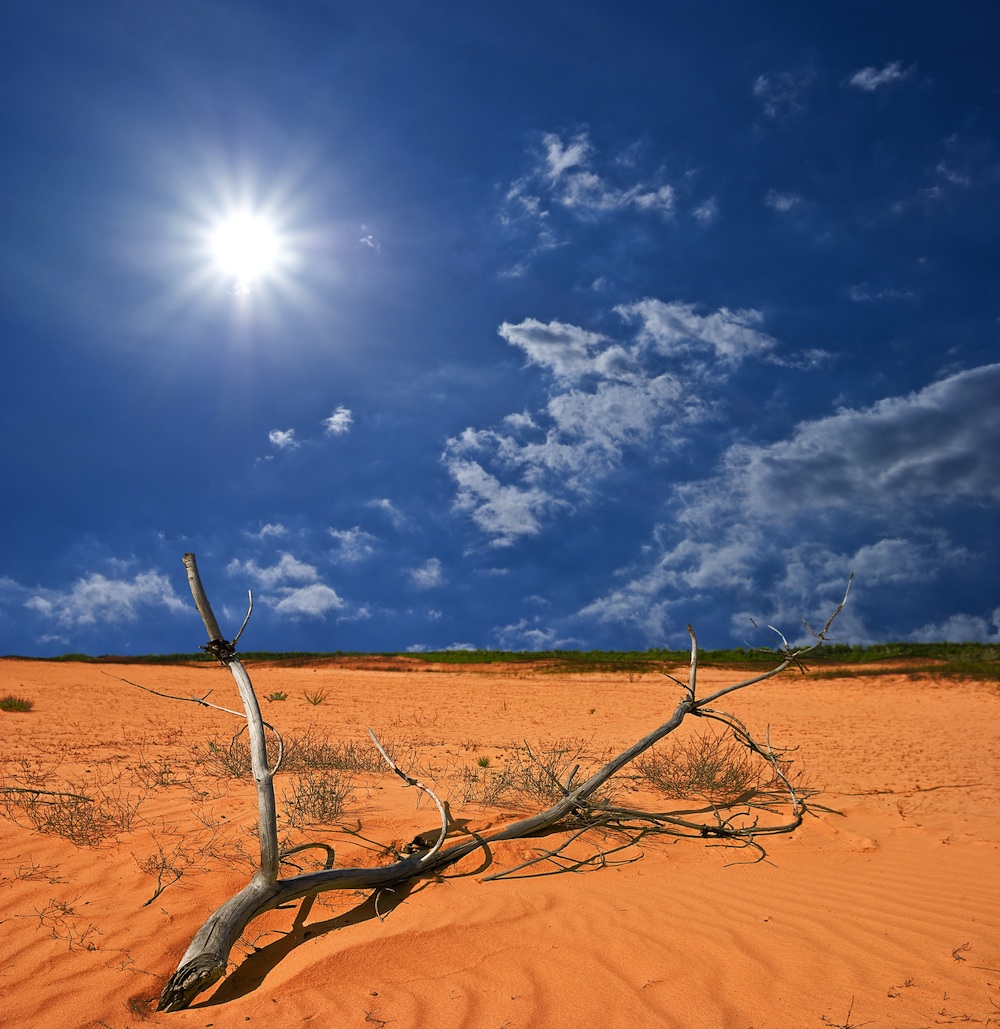
We can all buy hybrid and electric cars and install as many solar panels as we want, and we can work toward lowering greenhouse gas emissions worldwide—but climate change is starting to feel like a certainty. Perhaps we’re wasting our time and breath talking about how to prevent it, and we should start talking instead about how to live with it. In advance of the Zócalo event “Should We Just Adapt to Climate Change?”, we asked scientists: Assuming climate change is irreversible, what’s the best thing we can do now to prepare ourselves for a warmer world?

Adaptation is the word used by climate scientists to describe actions that can be taken to respond to new climatic conditions, thereby reducing harm or capitalizing on opportunity.
Mitigation is the word used to describe ways to reduce the amount and speed of future climate change by reducing greenhouse gases.
Our climate is already changing in response to the buildup of human-generated heat-trapping gases in the atmosphere. At various levels, actions to adapt and mitigate are underway all around the world. However, human-induced climate change is projected to continue and accelerate significantly if emissions of heat-trapping gases continue to increase.
Should billions of dollars be spent on sea barrier systems to protect New York or other coastal communities from the impacts of more frequent extreme storms?
Should tiny island nations buy land in other countries because continued rising sea levels will make farms unproductive or make communities uninhabitable?
Should farmers switch crops, irrigation systems, or lands because of the likelihood of more extreme droughts? Should forestry managers prepare for more devastating wildfires?
Should economically developed countries commit to reduce emissions while many developing countries remain reluctant?
Choosing “the best thing we can do now” is a false choice. Even if some of climate change’s impacts are irreversible, it is important to work on both adaption and mitigation.
The White House Science Advisor, Dr. John Holdren, famously said that we have three choices. We can adapt, mitigate, or suffer. In fact, he adds, we are already doing all three. His key question is—“What will the future mix look like?” More mitigation means less adaptation and less suffering.
There is no silver bullet to this problem. But, if there is a single “best thing” we can do now, it may be to teach youth around the world to be more wise and responsible than their ancestors have been.
Plácido dos Santos is an analyst with the University of Arizona’s Water Resources Research Center. He is a member of the U.S. National Climate Assessment Development and Advisory Committee.

At the center of our future survival is the ability to adapt our agricultural and food systems to provide for the nutritional needs of as many of us as possible in the face of climate change. In fact, climate change and extreme weather are already forcing major shifts in agricultural systems around the world, with consequences for human health, food price volatility, and political instability as well as environmental degradation. Current systems are far from adequate for the billions of people on the planet. Our goal must be to adjust our food systems to better meet human needs within ecosystem limits. Agricultural and social innovations, better water and soil management, and careful matching of food systems to human needs can help adapt food systems to climate change. But ultimately our future will depend on how well we can balance our demands for food, water, materials, and energy with our planet’s ability to meet those demands within short- and longer-term environmental limits.
The Commission on Sustainable Agriculture and Climate Change has outlined seven major areas for policy action that can guide our interconnected food and climate systems within a “safe operating space” for people and the planet. Directing public and private finance toward risk mitigation and productivity within ecosystem limits are critical areas for near-term action. Designing our food systems to better achieve nutritional health at scale with less waste would have immense benefits for the environment, public health, and economic vitality. While the threats we face to agricultural productivity from climate change are frightening, holistic approaches to innovations and renovations of food systems could produce improved outcomes in both human and environmental dimensions.
Molly Jahn is a professor in the Laboratory of Genetics and Department of Agronomy at the University of Madison-Wisconsin. Christine Negra leads the Secretariat of the Commission on Sustainable Agriculture and Climate Change, which was convened by CGIAR-CCAFS in 2011.

There are some simple solutions to the challenge of climate change. Take sea levels, which have risen about 30 centimeters in the last 150 years.
Across the globe, we have seen adaptation to much higher relative sea-level rises. Since 1930, excessive groundwater withdrawal has caused Tokyo to subside by as much as 5 meters—meaning many parts of Tokyo are way below sea level. Similar subsidence has occurred over the past century in numerous cities, including Tianjin, Shanghai, Osaka, Bangkok, and Jakarta. All these cities have managed to protect themselves without much difficulty.
New York City is rightly concerned about the 3.3 percent chance each year (a figure unaffected by global warming) that a Category 3 hurricane will hit the city, causing sea surges of up to 7.5 meters (about 3 meters higher than those caused by Hurricane Sandy), which would put Kennedy Airport under 6 meters of water. But much of this risk could be managed by erecting seawalls, building storm doors for the subways, and making other simple fixes like repaving the streets with more porous pavements—all at a cost of around $100 million a year.
Coping with rising sea levels is hardly the only place where low-cost, high-impact adaptation strategies can make a huge difference. One of the most pernicious impacts of global warming is the extent to which it exacerbates the phenomenon known as the urban “heat island effect”—the fact that because they lack greenery and are chockablock with heat-absorbing black surfaces such as tar roofs and asphalt roads, urban areas tend to be much warmer than the surrounding countryside.
One simple adaptive measure we can employ to cool down our cities: We can paint them. Hashem Akbari, a senior scientist at Lawrence Berkeley National Laboratory, has shown that by painting roofs white, covering asphalt roadways with concrete-colored surfaces, and planting shade trees, local temperatures could be reduced by as much as 2 degrees Centigrade.
Obviously, whether it involves dikes or buckets of white paint, adaptation is not a long-term solution to global warming. Rather, it will enable us to get by while we figure out the best way to address the root causes of man-made climate change. This may not seem like much, but at a time when fears of a supposedly imminent apocalypse threaten to swamp rational debate about climate policy, it’s worth noting that coping with climate change is something we know how to do.
Dr. Bjorn Lomborg is president of The Copenhagen Consensus Center. He is an adjunct professor at Copenhagen Business School.

The Earth is warming, sea levels are rising, and the weather is changing. We know that the Earth has warmed and will continue to warm due to the carbon dioxide we are releasing into the atmosphere by burning fossil fuels—and the warming is and will be disruptive. Five years ago the talk was “if” we limited the increase in the average surface temperature of the Earth to 2 degrees Celsius, then we would avoid “dangerous” climate change. It is now quite obvious that we see large, consequential, and disruptive changes with even less warming—for example in the melting of the Arctic Sea ice. The commitments the world has made have us on a path toward 3.5 degrees of warming or more. If we burn all our fossil fuels, the warming will be much greater.
We have no choice but to adapt to this warming world. We have adapted to changes in the climate for the past 10,000 years—it is something we do. Now, scientific investigation has given us a vision of the future that is credible and actionable. This is unprecedented in history, and it gives us the opportunity to take responsibility and plan to adapt. We know that the Earth will warm; we know it will warm fast. We also know that the weather will change, and when the weather changes the way rain and snow are distributed will be different.
To take advantage of this knowledge, we need to think through scenarios of what will happen to real places. We need to look at the impact of rising sea level on the Sacramento River Delta. We need to focus on how much water is stored in the snowpack of the Sierra Nevada and drought impacts on the forests, grasslands, and rangelands. We must move away from sweeping statements about more droughts and greater floods and instead play out the scenario and the cost of this warmer world to Culver City, California, to the people of California, and to the people of the United States. Then we can decide whether to build sea walls or move inland, rather than patching different strategies together as fragmented responses of emergency management.
Should we just adapt—and not worry about our continued emissions of our energy waste into the atmosphere, ocean, and land? What would be adapt to? We started talking about the “new normal” when we calculated, in 2011, the 30-year average of temperatures from 1981 to 2010, and a new, warmer average “replaced” the 30-year average of some earlier period. In 10 more years we will have the next warmer “climate,” then the next, and the next—the “next normals.” There is no new normal. And the warming will be speeding up. There is no “just adapting” to this; there is no stable climate to adapt to. We must manage and limit our carbon dioxide waste or we will still be chasing the “new normal” in a thousand years.
It won’t just be getting warmer. Ecosystems will have to adapt far faster than they did in the past 10,000 years. The trees of California will die from hot, dry weather. Intrusion of the sea into the Sacramento Delta will make Katrina in New Orleans seem like a quaint artifact of the “old normal.” The accelerated release of methane and carbon dioxide as the Arctic melts will accelerate the warming. The oceans will become acidic, and there will be vast changes to phytoplankton and zooplankton. The oceans will become warm and will release the carbon dioxide we take comfort in their storing. There is no “just adapting.” We will be required to adapt, and the rate of change will make adaptation ever more challenging. We need both aggressive reduction of greenhouse gas emissions to mitigate the future changes, and we need aggressive adaptation to cope with the changes already occurring and those that are in store.
Richard B. Rood is a professor in the Department of Atmospheric, Oceanic and Space Sciences at the University of Michigan. He also holds an appointment in the School of Natural Resources and Environment. Rood is the Climate Change Blogger for Wunderground.com.

As we saw last year—with record heat, drought, wildfire, and of course Hurricane Sandy—we are already experiencing the costly consequences of climate change. And with more than a century’s accumulation of greenhouse gases in the atmosphere, its impacts are bound to get worse. We must prepare for what is now unavoidable.
But that is only half the response. Even as we work to strengthen the climate resilience of our communities and critical infrastructure, we must quickly ramp up our efforts to avoid truly catastrophic impacts by dramatically reducing our greenhouse gas emissions.
The most effective and efficient way to do that is to put a price on carbon, the approach taken by governments in places including the European Union, California, and Australia. Unfortunately, the prospects for such legislation in the U.S. Congress are not good. So President Obama, who has now made an eloquent case for action in the face of climate change, needs to do all he can on his own. Actions the president can take using existing authorities range from boosting the fuel economy of heavy-duty vehicles and cutting carbon emissions from power plants to setting stronger energy efficiency standards.
At the same time, Washington must do more to strengthen our climate resilience. We need a national “climate service” to help states and localities apply long-term forecasts to their land use and disaster response planning. We need to reform our national flood insurance to reflect rising flood risk and ensure that structures rebuilt with federal assistance meet stronger building codes.
Across the board, governments and businesses must assess the vulnerability of our critical power, water and transportation networks, and our supply chains, and adapt them to the rigors of a warming world.
We must prepare for worse, while at the same time doing our best to avoid the worst.
Elliot Diringer is executive vice president of the Center for Climate and Energy Solutions (C2ES). He previously served as a Deputy White House Press Secretary and senior policy advisor at the White House Council on Environmental Quality, and authored several award-winning environmental series for the San Francisco Chronicle.



